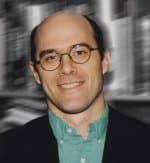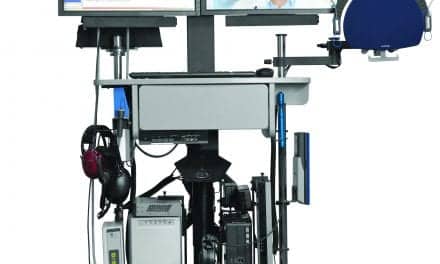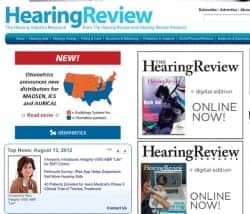
BHI has developed a new video and multimedia CD-ROM program, called The Better Hearing Institute Physician Referral Development Program, designed to spur nationwide physician referral and pair hearing care professionals with primary care doctors. “Primary care is where all the patients are, which means that’s where a lot of potential business is,” says Olive. “For whatever reason, we as an industry haven’t been able to reach them. Everything about managed care discourages people from using specialists, so that’s why we want to target these physicians.”
Olive is blunt about the need for dispensing professionals to be more aggressive in approaching doctors. “Basically, the industry’s been flat for nearly 2 decades, with very little growth,” he says. “Now there are close to 28 million people in this country with hearing loss—about 10% of the population. However, only 6 million people have sought treatment, which means we’ve only reached about 22% of those people who could use our services as an industry.” Olive adds that the 30-year-old BHI is jointly funded by manufacturers and suppliers, both of which back BHI’s marketing efforts. “They were wondering why they were spending money on us when our efforts weren’t advancing the market penetration of hearing aids,” he admits. “That’s when we came up with the new training program.”
Program Based on Sound Scientific Evidence
The new BHI program, designed to educate dispensing professionals in the basics of physician marketing, is actually based on a previous BHI educational campaign that involved a series of events throughout the country in which BHI acted as a facilitator in getting primary care physicians and dispensing professionals together in the same room. “When I first got here, I started a national lecture series to bring together physicians and hearing care professionals,” says Olive. “We created these 3- or 4-day events that were meant to spread the message of two very important studies that still make up the backbone of our new training program.”
The first study, which Olive refers to as “an important landmark,” was conducted in 1999 by the National Council on the Aging (NCOA) and published in the January 2000 issue of Hearing Review. “Essentially, the study showed that hearing loss is not benign, and that it has a profound impact on quality of life,” he says. “Up until that study, hearing loss in many ways was just seen as a normal part of getting older. On top of that, hearing aids carried a stigma with them, and people didn’t want to wear them for fear of appearing older. Many doctors actually did nothing to dissuade that type of thinking.”
An additional study, published in the October 11, 2000, issue of JAMA (for a summary, see the February 2001 Hearing Review, page 59), made up the other information supplied in the lecture program, says Olive. “That study, quite simply, proved that hearing aids work,” he says. “It showed that hearing aids provide substantial speech intelligibility and benefit over unaided conditions and reduce communication problems. So our overall message for physicians was this: In 90% of hearing loss cases, patients don’t need surgery, they need amplification. And here’s the hearing professional who can help you do that.”
In addition, the MarkeTrak VI article by Sergei Kochkin, PhD, in the December 2001 issue of Hearing Review showed that there is only a 14% chance that a primary care doctor will ask about the patient’s hearing during a general examination. “Those are the kinds of numbers we want to change, for obvious reasons,” he says. He adds that one more critical component of BHI’s message is technology. “Amplification is not only successful, but it is incredibly sophisticated today. That is one of the more important messages we want to get across.”
Armed with this information, BHI set up dinner events around the country, inviting both hearing care professionals and physicians to attend. “It seemed like a no-brainer,” remarks Olive. “The thought was that dispensing professionals would network with doctors, understanding that this was what they need to do to get a referral. But for some reason, we had very little success with the program.” In some ways, the challenge is similar to that faced by a pharmaceutical representative who is trying to gain the ear of a physician; the most difficult part is establishing and continuing a constant information exchange. Hence, Olive’s description of the “mating dance.”
| Get Your Local Physicians Referring! |
The Better Hearing Institute is currently offering a new 2-CD-ROM training program, The Physician Referral Development Program. The digital series is designed to stimulate new physician referrals for hearing care professionals. The first CD, entitled, "The Basics of Physician Referrals: A Course for Hearing Professionals," contains the following:
|
The second CD, titled "Hearing Loss: A Call to Action," is geared toward physicians and other medical staff. This program features:
|
| To participate in the program, enroll online at www.betterhearing.org. Or for additional information, contact BHI at (703) 684-3391. |
New CD-ROM Tutorial and Educational Program
Although the dinner events have been discontinued, Olive says the information and experience gained from those events were invaluable. The new CD-ROM program is largely based on the data from the NCOA report and JAMA article, as well as from the lectures that were presented at the events. “One of the things we realized is that, in order for hearing care professionals to see some growth in business, they need to understand how to approach doctors. So we interviewed primary care physicians about how referrals happen, and what they look for,” he says. Many of those interviews appear on the first CD-ROM in interactive video form.
That CD, launched in November 2001, is a “multimedia seminar in the basics of marketing yourself to physicians,” according to Olive. Featuring video lectures by Olive and a variety of doctors and other medical experts, the disc also includes PowerPoint slide presentations, a video introduction by neurotologist Michael Glasscock, MD, and complete footage of the presentations Olive had conducted. But perhaps the key to the package, according to Olive, is the interview footage with real-life doctors. “When the doctors speak, they’re essentially teaching you the concepts of what works and what doesn’t when you’re trying to get a foot in their door,” says Olive. “If you want to really know how to earn a referral, listen to them.”
Another highlight of the first CD-ROM is a self-testing component in which viewers are asked to type in the 10 most important lessons learned from a particular lecture, critical information, etc. “We’re trying to not only teach dispensing professionals how to make the contacts with physicians, but why it’s so important to make second and third visits,” says Olive. “And, of course, what to say and do in those subsequent meetings.”
The most important idea behind the first disc, he says, is to realize that there is a methodology in making five or six face-to-face contacts with any primary care doctor. “And even more important is to understand that, no matter what you’re armed with, what matters is that you keep meeting with them until they are familiar with you,” he says. “Ultimately, we urge the viewer to find every reason that the physician would be inclined not to use you, and be prepared with weapons of defense against that objection.”
When hearing care professionals finish the first of the two discs, there is a post-course evaluation, which is completed on an Internet site reached through hotlinks provided on the disc. Viewers take a 12-question test, with the results tabulated on a BHI database. “That way, we can check to see who’s completed it, and get an idea of how many people have gone through the program,” says Olive. To date, he says that 5,000 copies of the training series have been manufactured. “But there are more than 20,000 physicians who we believe should be participating in the program,”
CMEs for Doctors and Staff
Physicians and medical staff have a great incentive for being interested in the second CD, which is also now available. “That is actually the crown jewel of the program,” he says.
The reason for that? The second disc offers health care professionals, including doctors, nurses and related medical staff, the chance to get full Continuing Medical Education (CME) accreditation for finishing the course. It is a much more intensive program than the first disc, and includes a combination of live lectures by guest physicians, as well as different multimedia features designed to aid the student’s memory. “For example, we have interactive charts and graphs,” says Olive. “When you see the bar graphs showing how much better hearing aid users function and perform than their counterparts without the aids, it’s very dramatic. It’s also a great way to learn.” Olive says that BHI is the only organization at this point authorized to offer the CME accreditation through CD-ROM training programs, an honor bestowed on them by the American College of Continuing Medical Education (ACCME). “We were licensed to offer this one-hour digital course, and that is why we are so excited about it,” he says.
Obtaining the Program
The entire training course, according to Olive, is underwritten by the hearing industry, and costs a one-time $100 fee for participating hearing care professionals. “For that one-time fee, as an enrolled hearing care professional, you definitely get your money’s worth,” says Olive. “We ship you a package of materials to do outreach and referral development for 10 practices. Basically, what that includes is the first CD and test, and also the second disc with which doctors can obtain the CME credits. However, it also includes everything you will need for marketing yourself. We give you 10 reprints of each study, 10 posters featuring frequently-asked questions and telltale signs of hearing loss for doctors and their staff to put in waiting rooms. Now, if that works the way we hope, it will lead to referrals. Also, the questions on the posters will hopefully plant themselves in patients’ minds and lead to them querying their doctor about hearing loss.”
Olive says that BHI also includes referral pads, certificates for free hearing screenings, and other materials for dispensing professionals to have on hand for physician visits. “In the training program, we tell them to not be overly persistent, but also never be too far off the doctor’s radar screen,” he says.
Also, once hearing care professionals have completed the full training course and passed the test, BHI will send an additional set of 10 CD-ROMS and corresponding materials. “If you are motivated enough to do physician outreach to 1 or 5, or 20 or 30 primary care doctors, then you essentially get all the materials to do that at no additional charge,” says Olive.
As the program goes on, and hopefully becomes more successful and popular, Olive anticipates that participants will eventually be asked to pay more for the additional materials. “Even then, it’s a very minimal cost overall,” he says. “If you consider that you could cultivate lots of new referrals and new business for yourself, we feel the program more than pays for itself.”
For additional information on the program, contact BHI at (703) 684-3391; Website: www.betterhearing.org.
Ben Van Houten is associate editor of The Hearing Review. Correspondence can be addressed to Ben Van Houten, Hearing Review, 6701 Center Drive West, Ste. 450, Los Angeles, CA 90045; email: [email protected].





